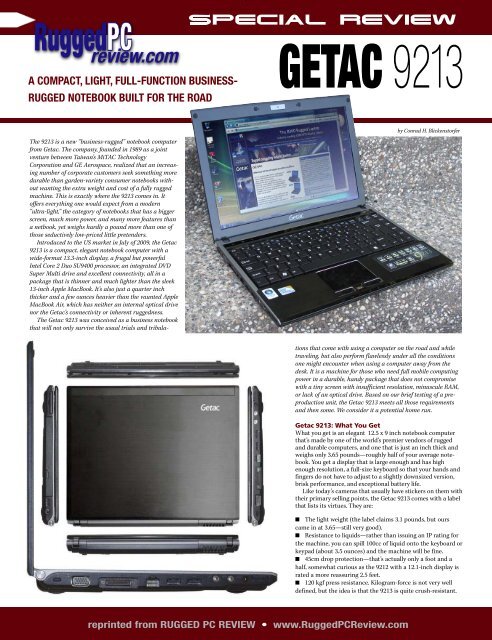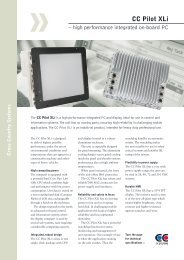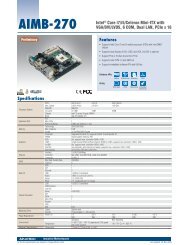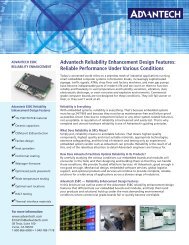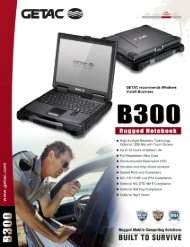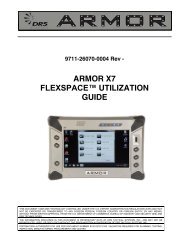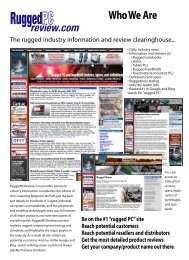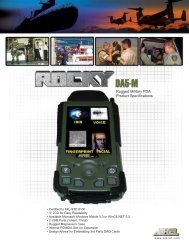Getac 9213 - Rugged PC Review
Getac 9213 - Rugged PC Review
Getac 9213 - Rugged PC Review
Create successful ePaper yourself
Turn your PDF publications into a flip-book with our unique Google optimized e-Paper software.
<strong>Rugged</strong><br />
review.com<br />
A COMPACT, LIGHT, FULL-FUNCTION BUSINESS-<br />
RUGGED NOTEBOOK BUILT FOR THE ROAD<br />
The <strong>9213</strong> is a new “business-rugged” notebook computer<br />
from <strong>Getac</strong>. The company, founded in 1989 as a joint<br />
venture between Taiwan’s MiTAC Technology<br />
Corporation and GE Aerospace, realized that an increasing<br />
number of corporate customers seek something more<br />
durable than garden-variety consumer notebooks without<br />
wanting the extra weight and cost of a fully rugged<br />
machine. This is exactly where the <strong>9213</strong> comes in. It<br />
offers everything one would expect from a modern<br />
“ultra-light,” the category of notebooks that has a bigger<br />
screen, much more power, and many more features than<br />
a netbook, yet weighs hardly a pound more than one of<br />
those seductively low-priced little pretenders.<br />
Introduced to the US market in July of 2009, the <strong>Getac</strong><br />
<strong>9213</strong> is a compact, elegant notebook computer with a<br />
wide-format 13.3-inch display, a frugal but powerful<br />
Intel Core 2 Duo SU9400 processor, an integrated DVD<br />
Super Multi drive and excellent connectivity, all in a<br />
package that is thinner and much lighter than the sleek<br />
13-inch Apple MacBook. It’s also just a quarter inch<br />
thicker and a few ounces heavier than the vaunted Apple<br />
MacBook Air, which has neither an internal optical drive<br />
nor the <strong>Getac</strong>’s connectivity or inherent ruggedness.<br />
The <strong>Getac</strong> <strong>9213</strong> was conceived as a business notebook<br />
that will not only survive the usual trials and tribula-<br />
SPECIAL REVIEW<br />
GETAC <strong>9213</strong><br />
reprinted from RUGGED <strong>PC</strong> REVIEW • www.<strong>Rugged</strong><strong>PC</strong><strong>Review</strong>.com<br />
by Conrad H. Blickenstorfer<br />
tions that come with using a computer on the road and while<br />
traveling, but also perform flawlessly under all the conditions<br />
one might encounter when using a computer away from the<br />
desk. It is a machine for those who need full mobile computing<br />
power in a durable, handy package that does not compromise<br />
with a tiny screen with insufficient resolution, minuscule RAM,<br />
or lack of an optical drive. Based on our brief testing of a preproduction<br />
unit, the <strong>Getac</strong> <strong>9213</strong> meets all those requirements<br />
and then some. We consider it a potential home run.<br />
<strong>Getac</strong> <strong>9213</strong>: What You Get<br />
What you get is an elegant 12.5 x 9 inch notebook computer<br />
that’s made by one of the world’s premier vendors of rugged<br />
and durable computers, and one that is just an inch thick and<br />
weighs only 3.65 pounds—roughly half of your average notebook.<br />
You get a display that is large enough and has high<br />
enough resolution, a full-size keyboard so that your hands and<br />
fingers do not have to adjust to a slightly downsized version,<br />
brisk performance, and exceptional battery life.<br />
Like today’s cameras that usually have stickers on them with<br />
their primary selling points, the <strong>Getac</strong> <strong>9213</strong> comes with a label<br />
that lists its virtues. They are:<br />
n The light weight (the label claims 3.1 pounds, but ours<br />
came in at 3.65—still very good).<br />
n Resistance to liquids—rather than issuing an IP rating for<br />
the machine, you can spill 100cc of liquid onto the keyboard or<br />
keypad (about 3.5 ounces) and the machine will be fine.<br />
n 45cm drop protection—that’s actually only a foot and a<br />
half, somewhat curious as the 9212 with a 12.1-inch display is<br />
rated a more reassuring 2.5 feet.<br />
n 120 kgf press resistance. Kilogram-force is not very well<br />
defined, but the idea is that the <strong>9213</strong> is quite crush-resistant.
REVIEW: GETAC <strong>9213</strong><br />
n 8 hrs. Battery Life—we’ll get to that farther<br />
down in the review.<br />
n Fingerprint sensor—definitely a plus in a<br />
machine geared towards business!<br />
n 60-Day Trial of MS Office—can do without that.<br />
n <strong>Getac</strong> Utility—This refers to two very useful<br />
utilities, G-Manager and ECO setting. More on<br />
those later.<br />
n Communication—WiFi and Bluetooth.<br />
n Webcam—A 1.3 megapixel cam with a very<br />
good dual digital microphone array.<br />
As you can see in the composite image on the<br />
prior page, the LED backlight allows for a very thin<br />
LCD case. The overall case is quite slender as well,<br />
and slightly wedge-shaped, with four rubber feet.<br />
Most of the connectivity is concentrated on the<br />
left side of the computer where you find two USB<br />
ports, a standard VGA connector, a docking/port<br />
replicator connector, an RJ45 LAN jack, audio<br />
in/out and a special S/PDIF interface for digital<br />
audio. S/PDIF stands for “Sony/Philips Digital<br />
Interconnect Format” and can be used to connect<br />
to things like home theaters that support Dolby<br />
Digital or DTS sound. There’s also a small lever to<br />
turn wireless on and off.<br />
On the right side is the DVD Multi Drive, a third<br />
USB jack, power, and an ExpressCard/34 slot.<br />
On the front is a 4-in-1 card reader that supports<br />
SD cards as well as Sony Memory Stick and Memory<br />
Stick Pro. Facing forward so that you can see them<br />
even when the LCD lid is closed are six control<br />
lights that show the status of wireless, AC/battery,<br />
charge, hard disk activity, caps lock and num lock.<br />
The full-size 87-key keyboard has black keys with<br />
white writing for primary symbols and blue for the<br />
couple dozen function key operations (including a<br />
numeric keypad). The keyboard is well organized<br />
and provides good tactile feedback. Above the<br />
keyboard are three “Quick Buttons.” They light up<br />
when you touch them and then slowly fade away.<br />
One launches Internet Explorer, one is user customizable,<br />
and one let you very quickly set the<br />
desired power savings mode. All indicator lights<br />
and icons are tiny and very faint. They certainly<br />
never get in the way.<br />
The touchpad and mouse buttons have sort of a<br />
black mirror finish that looks very elegant, but can<br />
result in unwanted reflections.<br />
The overall design theme of the <strong>Getac</strong> <strong>9213</strong> is<br />
matte-black, gloss-black and a bit of powdercoated<br />
silver. It’s a very elegant combination and makes for<br />
an overall very elegant, understated design. The<br />
<strong>Getac</strong> <strong>9213</strong> also feels remarkably solid and robust<br />
for such a light machine. The only drawback is that<br />
the elegant matte-black brushed top of the computer<br />
is quite smudge- and fingerprint-prone.<br />
Performance and battery life<br />
In terms of performance, notebook computers<br />
generally require a compromise between performance<br />
and battery life. Faster processors need more<br />
power, which means a larger battery, which means<br />
higher weight. If prolonged use away from a power<br />
outlet is anticipated, a manufacturer will use a<br />
frugal processor that still delivers good performance.<br />
That is what <strong>Getac</strong> did by selecting the Intel<br />
Core 2 Duo SU9400, an ultra-low power dual core<br />
processor using advanced 45 nanometer lithography<br />
and running at 1.4GHz. Thermal design power<br />
(defined as the maximum amount of power a<br />
computer’s cooling system needs to dissipate and<br />
used by Intel as a measure of power efficiency) is<br />
just 10 watts—only a fraction of what more desktop-oriented<br />
mobile processors use.<br />
We benchmarked the <strong>Getac</strong> <strong>9213</strong>’s performance<br />
with Passmark Software’s PerformanceTest 6.1 that<br />
runs about 30 tests covering CPU, 2D graphics, 3D<br />
graphics, memory, and disk and then computes<br />
scores for each category and an overall PassMark<br />
score. For comparison we added the results of<br />
<strong>Getac</strong>’s own fully rugged B300 notebook as well as<br />
those of the semi-rugged <strong>Getac</strong> P470. The benchmark<br />
results show how it all fits together.<br />
Despite its frugal nature, the <strong>Getac</strong> <strong>9213</strong>’s<br />
SU9400 processor provides very good performance.<br />
Anyone considering a <strong>Getac</strong> machine but wondering<br />
if performance might be much less than that of<br />
<strong>Getac</strong>'s rugged notebook lineup will find that the<br />
new machine is remarkable quick, with benchmark<br />
performance within 5% of the B300 and 20% of the<br />
P470 despite its very power-efficient processor and<br />
significantly lower clock speed.<br />
Now how about battery life? In the specifications<br />
on its website, <strong>Getac</strong> claims up to 12 hours of<br />
battery life for a system that is equipped with the<br />
optional secondary battery. The <strong>9213</strong>’s standard<br />
battery is a very compact 11.1 Volt/5,200mAH (57.7<br />
watt-hour) Li-Ion pack that fits flush into the<br />
backside of the computer. That’s a hefty supply of<br />
battery power for such a compact and light notebook<br />
and we eagerly awaited the results of our<br />
PERFORMANCE <strong>Getac</strong> <strong>Getac</strong> <strong>Getac</strong><br />
<strong>9213</strong> B300 P470<br />
Processor Intel Core 2 Duo SU9400 Core 2 Duo L7500 Core 2 Duo T7200<br />
Clock speed 1.40 GHz 1.60 GHz 2.00 GHz<br />
Thermal Design Power 10 watts 17 watts 35 watts<br />
CPU Mark 838.4 893.9 1085.2<br />
2D Graphics Mark 176.0 158.5 295.2<br />
Memory Mark 347.9 400.0 492.2<br />
Disk Mark 390.2 343.3 277.8<br />
3D Graphics Mark 102.0 138.3 154.8<br />
Overall PassMark 402.9 420.8 498.0<br />
BatteryMon power drawdown test.<br />
As it turns out, idle drawdown is a very low 7.2<br />
watts, and that is with all the default settings. With<br />
the brightness at its lowest (but still completely<br />
visible) setting and wireless off, we saw as little as<br />
6.1 watts (see screen capture). That is remarkable.<br />
Divide 57.7 watt-hours by 6.1 watts and you get<br />
almost 9.5 hours right there. Real world battery life,<br />
of course, depends on usage and operating conditions.<br />
Running resource-intensive applications such<br />
as video will use more power, but depending on<br />
power settings, the system will also go into stand-by<br />
and thus extend battery life.<br />
As is, the <strong>Getac</strong> <strong>9213</strong> seems to be an exceptionally<br />
power-efficient system. In fact, of the dozens of<br />
Intel Atom-based systems we’ve benchmarked at<br />
<strong>Rugged</strong><strong>PC</strong><strong>Review</strong>.com, only a couple were able to<br />
draw less power at idle than the much more powerful<br />
<strong>Getac</strong> <strong>9213</strong>. Six to eight hours of continuing<br />
operation ought to be possible on the main battery,<br />
and so the 12 hours claimed by <strong>Getac</strong> with the<br />
secondary battery installed seems achievable.<br />
<strong>Getac</strong> Utility<br />
Like most mobile hardware these days, the <strong>Getac</strong><br />
<strong>9213</strong> comes with several optimization utilities. ECO<br />
lets you manage the computer's power settings<br />
(balanced, high performance, power saver). You can<br />
also create profiles with Bluetooth and WiFi separately<br />
on or off.<br />
G-Manager shows system information in summary/graphics<br />
format for system, battery and<br />
various types of monitoring—CPU clock, load,<br />
voltage and temperature; fan speed; hard disk speed<br />
and free space; WLAN activity; as well as free<br />
physical and virtual RAM.<br />
Excellent display<br />
Sunlight-readability is rapidly becoming a major<br />
selling point in the rugged notebook market. That<br />
makes sense as most rugged and semi-rugged<br />
notebooks will likely see outdoor duty, and it is just<br />
as important in business-rugged notebooks as they<br />
may well be used outdoors at times. While most<br />
standard transmissive LCD displays wash out in<br />
daylight, the <strong>Getac</strong> <strong>9213</strong>’s display does not. The first<br />
picture on the next page was taken on a very bright<br />
California summer day at about 10AM. The computer<br />
is sitting in partial shade and the picture is<br />
completely unenhanced.<br />
Though <strong>Getac</strong> does not specifically mention<br />
optical coating, a degree of coating must be there as<br />
the image remains very visible in direct sunlight.<br />
That, however, is only part of the story. While the<br />
<strong>9213</strong> does not have the superbright 1,200 nit backlight<br />
used on the company’s B300 and V100 notebooks,<br />
the LED backlight is considerably brighter<br />
than what we usually see on consumer notebooks.<br />
Backlight brightness is controlled via a function key<br />
combination and goes from quite dim to full bright<br />
in 16 steps.<br />
The next picture shows the <strong>9213</strong> directly facing<br />
the 10AM morning sun. This is the most challenging<br />
test for any LCD as no backlight can compete<br />
with the power of the sun. What matters in this<br />
situation is effective optical coating and polarizers.<br />
As you can see, the <strong>9213</strong> display remains visible and<br />
readable. The screen takes on a somewhat greenish<br />
cast and reflection can become an issue. It is actually<br />
not as much of a problem as you might expect as<br />
the human brain is very good at tuning out reflection<br />
and concentrating on the image itself. The<br />
third picture shows that the <strong>Getac</strong> actually handles<br />
reflection much better than a standard notebook.<br />
I didn’t expect the <strong>9213</strong>’s display to be as good<br />
outdoors as it is. Almost all notebooks today have a<br />
reprinted from RUGGED <strong>PC</strong> REVIEW • www.<strong>Rugged</strong><strong>PC</strong><strong>Review</strong>.com
REVIEW: GETAC <strong>9213</strong><br />
glossy display surface that “pops” when viewed<br />
indoors, but often results in distraction reflections.<br />
The <strong>Getac</strong> <strong>9213</strong> both remains very readable<br />
outdoors, even in direct sunlight, and it<br />
also handles distracting reflections much better<br />
than most commercial consumer notebooks.<br />
As far as viewing from different angles goes,<br />
the <strong>9213</strong>’s display has what appears a perfect<br />
180 degrees viewing angle horizontally. The<br />
vertical viewing angle, however, is significantly<br />
narrower, with the usual chromatic changes as<br />
you look at the screen from varying angles. That<br />
is about par for the course with most of today’s<br />
notebook LCDs.<br />
Security<br />
Like most mobile hardware these days, the<br />
<strong>Getac</strong> <strong>9213</strong> offers various levels of hardware and<br />
software security to prevent unauthorized<br />
access as well as theft.<br />
Specifications<br />
<strong>Getac</strong> <strong>9213</strong><br />
Type: Business-rugged notebook computer<br />
Housing: Magnesium alloy chassis<br />
Processor: 1.4GHz Intel Core 2 Duo SU9400 with 3MB<br />
L2 cache and 800MHz FSB (TDP 10 watts)<br />
Chipset: Intel GS45 + ICH9M-SFF<br />
Video: Mobile Intel GMA 4500MHD<br />
OS: Windows XP Pro, Vista Business or Windows 7<br />
Memory: 1 to 3 GB DDR2<br />
Expansion slots: 1 Express Card 34/54mm, 4-in-1 card<br />
reader (MMC, SD, MS, MS-PRO)<br />
Display: 13.3-inch/1280 x 800 pixel sunlight-viewable<br />
TFT with LED backlight<br />
Digitizer/Pens: None<br />
Keyboard: Integrated 87-key, full-scale, water-resistant<br />
Storage: 2.5-inch SATA 160 to 250GB, optional 32 or<br />
64GB SSD<br />
Optical drive: DVD super-multi optical drive in media<br />
bay (or optional 2nd battery)<br />
Size: 12.5 x 9.0 x 1.0 inches<br />
<strong>Rugged</strong>ness: Operating temperature 32 to 95F,<br />
Vibration & drop resistance, crush-resistant to<br />
120kgf, shock-protected HD, 1.5 feet drop<br />
Weight: 3.625 lbs. with battery as tested<br />
Security: TPM 1.2, fingerprint scanner, Kensington lock<br />
Power: Li-Ion (11.1V, 5,200mAh; 57.7 watt-hours; up to<br />
8 hours), optional 27 watt-hour media bay battery<br />
("up to 12 hours")<br />
Communication: Intel WiFi Link 5100 802.11a/g/n WiFi;<br />
Bluetooth Class II v2.1 + EDR<br />
Interface: 3 USB 2.0, RJ11, gigabit RJ45, dock/port<br />
replicator, audio in/out, S/PDIF, VGA video, 1.3mp<br />
camera, fingerprint scanner<br />
Price: US$1,799 (3GB RAM, 160GB drive, 3 yr warranty)<br />
Contact: <strong>Getac</strong> • us.getac.com • 1-866-464-3822<br />
reprinted from RUGGED <strong>PC</strong> REVIEW • www.<strong>Rugged</strong><strong>PC</strong><strong>Review</strong>.com
REVIEW: GETAC <strong>9213</strong><br />
The VitaKey one-touch identity protection<br />
software suite from EgisTec handles Fingerprint<br />
scanning. VitaKey works in conjunction with the<br />
<strong>9213</strong>’s fingerprint scanner, supports the Windows<br />
logon, and also multi-user logon scenarios. You can<br />
also create a “password bank” to protect websites<br />
and applications that need user names and passwords.<br />
VitaKey can handle file protection with<br />
encryption and decoding via fingerprint access,<br />
and you can also use the system to launch and<br />
protect applications.<br />
As part of its security, the <strong>Getac</strong> <strong>9213</strong> uses<br />
Trusted Platform Module (TPM) 1.2 hardware to<br />
create and manage computer-generated digital<br />
certificates. Combined with software, these certificates<br />
can be used to:<br />
n Send and received secure email,<br />
n Set up the browser for client identification,<br />
n Sign Word macros,<br />
n Encrypt individual files or entire folders, and<br />
n Create secure network connections.<br />
n To use TPM, you have to enable TPM support<br />
in the BIOS and also install the TPM driver.<br />
All of this can get pretty involved. Some users<br />
may never implement TPM or even passwords,<br />
whereas others may be set up in accordance with<br />
their company's IT security procedures, or they<br />
may configure an individual system for maximum<br />
security. The good news is that all the security<br />
tools are there.<br />
Beyond all the electronic defense and protection<br />
measures, don't forget physical security and get a<br />
Kensington locking cable to use with the Kensington<br />
slot on the left side of the unit. It is inexpensive<br />
insurance against theft.<br />
<strong>Rugged</strong>ness<br />
<strong>Getac</strong> considers the <strong>9213</strong> a “business-rugged”<br />
computer capable of absorbing a degree of rough<br />
handling and demanding environmental conditions.<br />
The computer is quite light, but it feels tough<br />
and sturdy. There aren’t any rubber bumpers that<br />
would add extra protection (but also bulk). As is,<br />
the solid construction of the machine, the shock<br />
protection of the hard disk, and the shock-mounting<br />
of other sensitive components combine to let<br />
the machine survive drops from 2-1/2 feet when off<br />
and a foot and a half while operating.<br />
As for environmental specs, the <strong>9213</strong> has an<br />
operating temperature range of 32 to 95 degrees<br />
Fahrenheit. So using it in freezing temperatures or<br />
desert climates is out. The computer can handle<br />
non-condensing humidity from 10 to 90%. The<br />
<strong>9213</strong> does not have an IP rating, but the keyboard,<br />
touch pad and buttons are spill-resistant. And<br />
<strong>Getac</strong> also rates the <strong>9213</strong> as crushproof with a<br />
maximum of 265 pounds onto its surface and 33<br />
pounds onto its thin LCD housing.<br />
<strong>Getac</strong> also lists compliance with a variety of<br />
governing standards and regulations in various<br />
markets. These can be difficult to summarize in a<br />
review and they also vary depending on markets.<br />
Inquire with <strong>Getac</strong>.<br />
Summary: <strong>Getac</strong> <strong>9213</strong><br />
The <strong>Getac</strong> <strong>9213</strong> is for those who need a full-function notebook<br />
to take with on the road and other places that include traveling and the occasional drop or spill. Further, it’s for those who want for<br />
their computer to be light and handy, but still offer a display large enough to do real work on. The <strong>9213</strong> fills those requirements in<br />
an elegant package that measures 12.5 x 9 inches, is just an inch thick, and weighs only 3.6 pounds.<br />
Unlike netbooks, the <strong>Getac</strong> <strong>9213</strong> neither compromises performance<br />
nor functionality. Its efficient yet powerful 1.4GHz Intel Core 2 Duo<br />
SU9400 processor provides speed and responsiveness very close to that<br />
of <strong>Getac</strong>’s larger rugged and semi-rugged computers. You also get adequate<br />
onboard ports and connectivity as well as quick SATA disks up to<br />
250GB and a flexible media bay with a DVD Super Multi drive. There is<br />
plenty of onboard security, including a fingerprint scanner. An integrated<br />
1.3 megapixel camera allows video conferencing.<br />
The frugal processor, LED backlight, properly sized battery, and efficient<br />
design of the <strong>9213</strong> make for excellent battery life.<br />
In terms of wireless communications, there’s Bluetooth and<br />
an integrated Intel WiFi Link 5300 module supports 802.11a/g/n.<br />
The <strong>9213</strong> comes with a bright 13.3-inch display that uses the<br />
“wide” 1280 x 800 pixel format with a 16:10 aspect ratio. Thanks to<br />
very effective optical coatings and filters, the screen offers excellent<br />
sunlight viewability with only modest reflections.<br />
Overall, the <strong>Getac</strong> <strong>9213</strong> is a smartly designed business-rugged<br />
machine that offers full commercial<br />
notebook functionality and long battery<br />
life in an attractive, lightweight package<br />
that is far more durable and<br />
able to handle the occasional<br />
spill and drop. The price of a<br />
fully equipped <strong>9213</strong> is US$1,799, considerably<br />
more than a consumer notebook,<br />
but a downright bargain considering its <strong>Getac</strong> pedigree,<br />
long 3-year warranty, and sturdy build quality.<br />
Contact: <strong>Getac</strong> • us.getac.com • 1-866-464-3822<br />
reprinted from RUGGED <strong>PC</strong> REVIEW • www.<strong>Rugged</strong><strong>PC</strong><strong>Review</strong>.com


